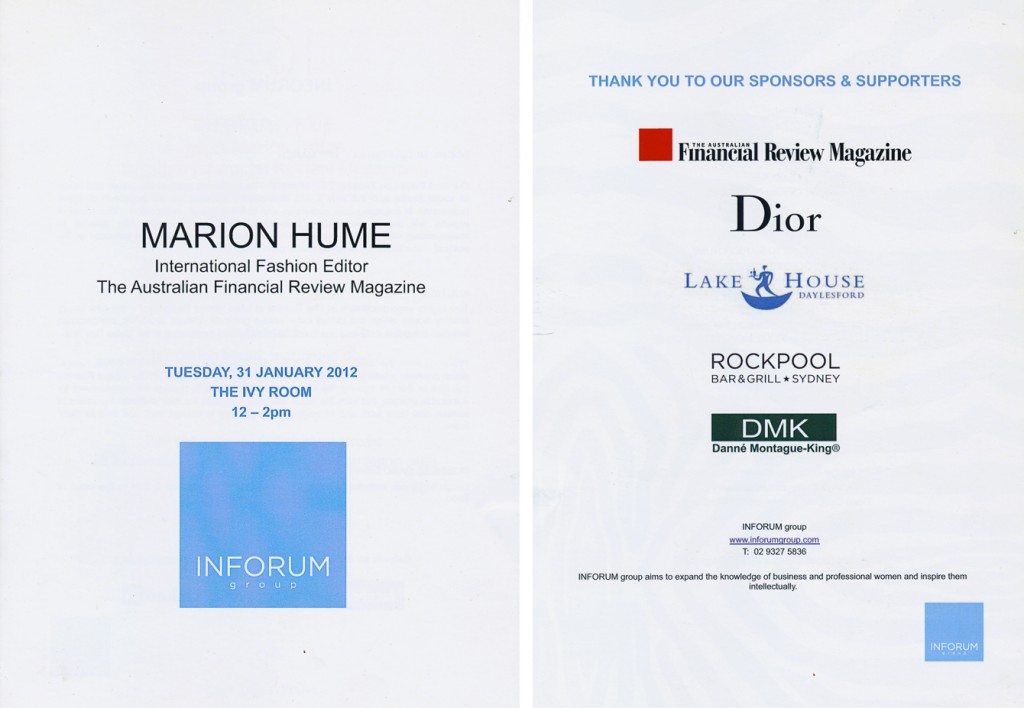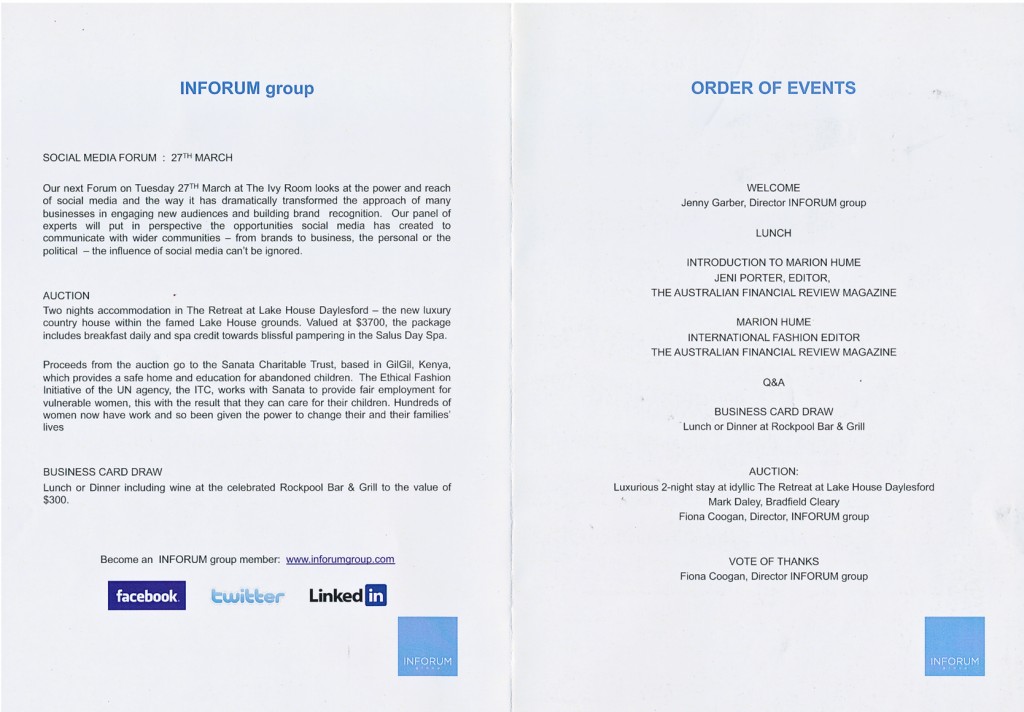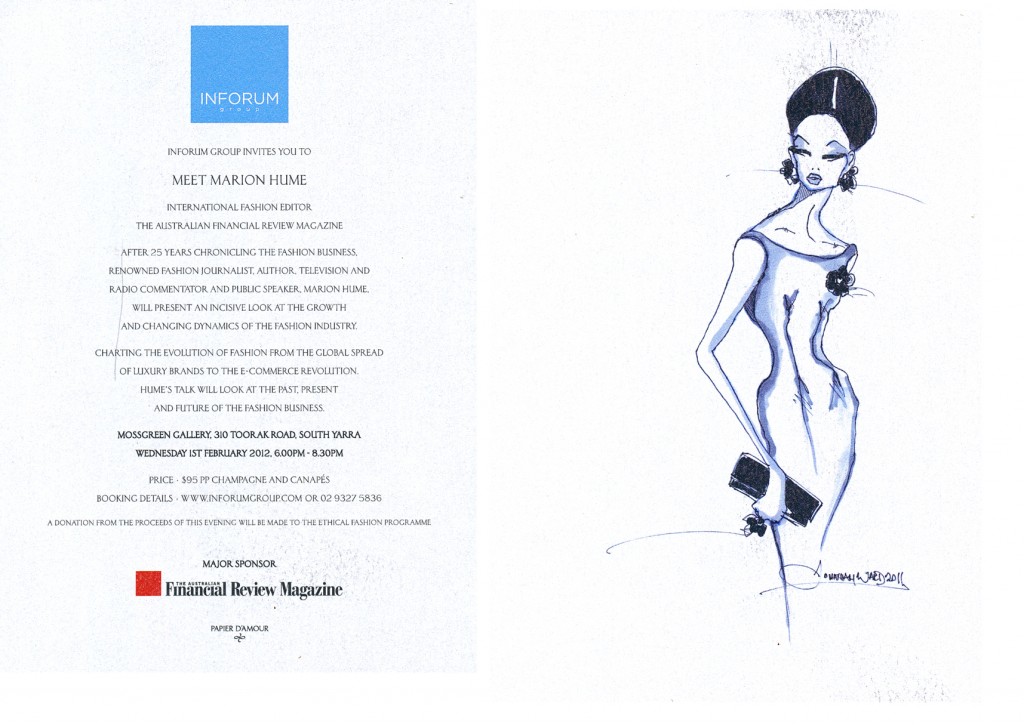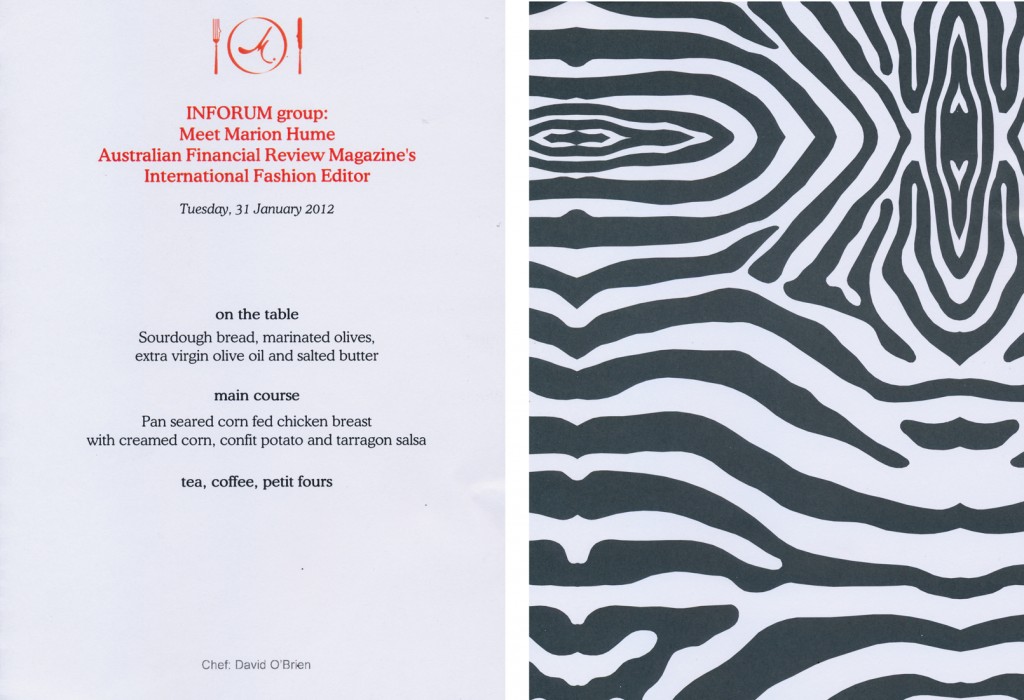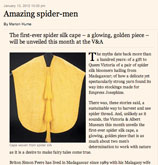Pinstriped Prankster
AFR Magazine | February 2012
by Marion Hume
Like his impeccably tailored jackets that swing open to reveal a bounce of cheeky colour, Nottinghamborn Paul Smith is a cautious if somewhat laid-back businessman with a flair for the quirky and the original. The hugely successful joker in the pack talks to Marion Hume ahead of opening his first Australian store in Melbourne.
In photographs, Paul Smith (correctly, Sir Paul Smith-although he doesn’t use the title) can look a bit miserable like he’s got a stone stuck in his shoe. This is odd and not only because you’d think the chairman, designer and- with his childhood sweetheart-co-owner of a world famous brand with a turnover of £171.6 million ($257.5 million) would have something to smile about. What’s discombobulating is that in real life the man with the everyman name is all joy. The living breathing Paul Smith, as opposed the glum chap through the lens, makes you wish he’d invite you to lunch. With all due respect, you don’t say that about Giorgio Armani.
His appeal, like his clothes, is a simple equation: straightforward + quirky, with a sense of humour. In business, he’s not grasping. The arc of Paul Smith ltd has been steady, not greedy. The London HQ is full of people who hold open doors for each other and smile a lot, but not in a creepy way because the boss is watching. As for when the boss is being watched, he’ll be in a good suit and carrying a good man-bag, from which he might pull a rubber chicken.
Every year, Suzy Menkes, the doyenne of global fashion, hosts The International Herald Tribune Luxury Summit, a pay-thousands-to-attend gathering which is the frock-world version of Davos. Industry titans take it so seriously, they hire writers and coaches to help with their strictly-timed 20 minute speeches. When it was Paul Smith’s turn to share knowledge of a business he’s been in since the early 1970s, he bounded onto the stage, pulled out an alarm clock, mucked up his PowerPoint and then, when clanging from the clock signalled time up, delivered his final piece of advice; if you are nervous about a meeting, bring a silver briefcase that opens up to reveal a train set. Because who doesn’t love playing with a train set?
In April, a Paul Smith store will open on Melbourne’s Collins Street, which raises the obvious question “what took so long?”- especially as Smith himself has no qualms baout long-haul travel (he’s been to Tokyo more than 80 times). The brand has successful relationships with David Jones and Sydney independent retailer Robbie Ingham. “I heard Prada are planning to open 80 shops this year. We want to move forward when it feels right, not be aggressive”, is Smith’s own explanation.
He does what he thinks is right, including flying to Japan, where he has more than 200 stores and over 1,000 staff, as soon as he heard about last year’s tsunami and the Fukushima meltdown. He was on the 42nd floor, when the aftershocks hit Tokyo. “It was scary and there was the radiation worry but I thought I should just go and give people who have worked for me for 20 years a hug, especially as everyone else was leaving.”
Paul Smith, born 5th of July 1946, is 65 (although when I ask, he says 63) and the life arc goes like this; young lad from Nottingham in what was once Britain’s clothing manufacturing heartland, wants to be professional racing cyclist, leaves school at 15, has accident aged 17, six months in hospital, starts working in shop, thinks he might as well have his own shop and is encouraged by his girlfriend, Pauline Denyer (now his wife) to take a space down a back alley with a rent of 50p a week.
Soon, he starts mixing in his own stuff, inspired by the garb of the working men of a big industrial city, in amongst hard-to-find labels and jeans imported from the US. By 1976, he’d showen the first menswear collection under the Paul Smith label in Paris and opened a store in London’s Covent Garden, near what was then the rat-infested fruit market (which closed down in 1979). Forever dubbed “classic with a twist”, that label-which mixes unexpected flashes of colour with solid blokey darks- is now attached to menswear, womenswear, jeans, shoes, scent, eyewear, watches, pens, furniture, rugs and bikes.
Of the latter, you can’t miss the sherbet pink bike in the crazy lair that is Paul Smith’s own office within his London HQ. While most of the building looks familiar if you’ve visited stores kitted out in lovingly salvaged old wood, the designer/chairman’s office, which is about the size of a country schoolroom, is a surprise. Every surface – every bit of wall, every inch of floor – is littered with stuff; fine art mixed with daft kids toys, exquisite mid century furniture topped by an Aussie bush hat and a joke giant spider (he apologizes that the battery has gone flat so he can’t make it crawl all over me).
“There are lovely things in here. And there are hideous things and cheap things and expensive things. I buy things and things get sent to me because I’ve got quite a reputation for liking unusual things. I’ve got this unknown person who has been sending me things for 20 years: a football, a traffic cone, a ski. And the thing is, they never arrive in a box, they always arrive as just stuff with stamps stuck on it. We call it “the stamped objects collection”. And the sender? “No idea. But when the stuff is particularly mad, I do wonder how Tom Ford or Giorgio Armani would react.”
At the thought of either of fashion’s minimalist perfectionists receiving a stamped didgeridoo, Smith lets out a schoolboy giggle. “I was on a train coming from the north of England last week and the hotel where we’d stayed, a funny little country hotel, had made us packed lunch in a Tupperware box and I thought, ‘I’m not sure Mr. Armani would be doing this’.”
Like Armani’s, this is his own gig; a company built in his image. “ Everything here has a meaning to me,” Smith is saying as he points out a funny paper owl. “It’s about being open and not following and not looking at magazines and seeing what other people are doing and going shopping and saying ‘well, they’re doing that’, I’ve got a very open mind so I look at small and big and rough and smooth and kitsch and beautiful. I’m a very spontaneous person and I like things at my fingertips to take inspiration from.” With no children of his own, he says, “I think it’s the child-like mind that I enjoy because I think children are so free of education and experience.”
In terms of certificates on paper, so is Paul Smith. He has no formal fashion training, barring a night school tailoring course. As for the business side, that’s self taught too. “I don’t even know what an MBA is,” he replies when I ask if he’s got one. How big is your business now? How many shops do you have? I ask. “We’ve got all sorts… I’ve got it written here somewhere…a lot”. How many countries do you sell in? “Over 50”.
And the turnover? “The thing is, I know we’re doing well and we’ve never gone backwards and I know I get the weekly takings in the shops and I know which ones are doing not so well and which ones are doing better. And when they’re not doing so well, it’s usually because it was pouring with rain or snowing. We’ve never borrowed money, we own the buildings, we own the warehouses, we’ve got about 1,000 staff at Paul Smith and about 1,000 in Japan.”
So he’s rich. “I’ve got some money,” he mumbles. “I can probably spend a bit of money but it’s almost like the jam jar on the mantelpiece at your granny’s. Well, it’s never been as naïve as that but Pauline and I are quiet people and we are very fortunate to have met each other. We’ve never been searching for a Rolls Royce or a yacht or a stately home.”
Instead the couple live in a big, not grand house in Notting Hill. They have been spending summers in Tuscany since way before it was fashionable, “at a very remote farmhouse not a posh villa. What Smith is most proud of is that running “a good business and a profitable business,” means staff sharing in long-term security. “I’ve just written three cards to staff that have been with me for 20 years. So everything about it is a perfect business model, and we’ve won awards and I got a knighthood.”
In 2001, Paul Smith and Pauline Denyer left Buckingham Palace to get married, although they met when he was 21 and she was 27 and they’d been living together since 1967. Sir Paul did think about refusing the honour – “well, it’s not really me” – but staffers said if his mum and dad had still been around, they’d be so proud. Does he use sir ever? Let’s see his credit cards. They say plain P B Smith and the signature’s exactly the same neat script as the one on the label.
Along with clothes (good solid suitings, a bit of a stripe, floral shirts and boxers; so racy when he started that idea) there has always been curios and gadgets, a mix that is familiar in the retail landscape now but wasn’t before Paul Smith started it. In the late 70s, he unearthed an old leather-bound personal organiser called a Filofax in a tiny shop hidden under an East London railway arch. The Filofax became to the 80s what the iPhone is today. While Paul Smith doesn’t have an iPhone, he’s an avid blogger, “and as a company we’re massively high-tech. We have this room in Nottingham which is like being on a space ship, which is where the brains are. We’ve got five huge warehouses and one sends out 3 million pieces of kit a year, and it’s got 90 staff. I went in last week and immediately got goosebumps.”
When in London, he rises at 5 am and guns his tiny Mini Cooper across town to the RAC club where he swims, “sometimes only for 10 minutes, sometimes half an hour depending on my mood, then I get into the office at six-ish with the cleaners.” Lots of his appointments these days involve the press, although rarely to toot his own trumpet. He financially supports London’s Design Museum and The Tate, so he’ll show up for those and many things connected to the arts. He’s done the interiors for Maggie’s, which has respite centres across Britain for those suffering from or connected to those with cancer. “Oh and last week a day trip to Dubai and I’m just back from Japan.”
In the early 80s, Japan was to fashion what China is now, except fashion’s players were far more parochial. When Paul and Pauline were invited to visit, they flew economy via Anchorage. He recalls the feeling: “So excited to go to this place we never thought we’d be able to see because it was so far away and so expensive. We had a modest business then. I couldn’t believe they actually wanted to have an agreement with me.” Back then, lots of European designers got Japanese deals, then faxed a few fast sketches a couple of times a year until the second-rate stuff didn’t sell and it was over. In contrast, Paul and Pauline went again and again. “I was all energy, enthusiasm, willingness. So I think it’s not a miracle we’ve done well in Japan”.
He doesn’t speak Japanese and uses jokes to communicate. “Providing you get the timing right, humour is fantastically important”, he says. “I think I have learned my discipline and the importance of cut and shape and being modest and down to earth from Pauline. But from my dad, I got the skill of communication. He passed away when he was 94 and he still had young friends.” Smith has yet to crack Chinese humour and so the Chinese market. “We’ve got a good business in Hong Kong and from this year, we’re entering into mainland China. Most of the brands that do well there have very identifiable logos. But with Paul Smith, there’s none of that, so I’ve been holding back. And now there’s a younger generation of 17-25 year olds that are quite big Paul Smith fans.”
A lack of bold logos notwithstanding, counterfeiters is rife. “We have full-time lawyers on it, we have the merchandise destroyed but it starts again round the corner.” Or in plain sight in the case of Bali, where the fake Paul Smith stores are well known to Australian travellers. “I use the word ‘disappointed’,” says Smith. “When there’s thousands of talented fashion students, many of whom come from Asian countries, why not let them work from a blank sheet of paper and do something new?”
When a designer owns his company and is 65 (or 63 by his own count) it invites a question that is never easy to ask. “The answer is not clear and it’s something we talk about [and] then immediately push to one side,” is his reply. “There is a very good team, we do everything in-house: design, press, marketing, shop design, architecture, no shareholders. That’s the joy…We still have the possibility of growing the business. Now we’ve got Melbourne and we could open Sydney and we’ve got Amsterdam coming up. We don’t need to grow massively because there’s no one pushing us to grow.”
He’ll come out to Melbourne for the shop opening and the store will, doubtless, have that intrinsic mix of plain darks with bold shots of colour. “although there are still taboos about what men can wear.”, he says. “I had one of my lads in the other day and he got a shirt with polka dots on it and he came in the next day and said he’d had it on at breakfast and all his kids burst out laughing. We’ve got more of a reputation for colour than actually what we sell. If you were to look at the figures, you’d find the bulk of what we sell are navy blue suits, masses of white shirts, navy blue sweaters.”
And what relationship does the Paul Smith woman have with the Paul Smith? “They could be a couple. I do five lines for men and three lines for women. As the businesses grow, you are attracting a broader audience, but in my head, my boy and my girl are skinny, boyish figures.” Just like Paul and Pauline, now just as when they were young. “Yes, we’re both skinny, long-limbed. We both love tailoring, we both love simplicity and that’s what has attracted me really”.




